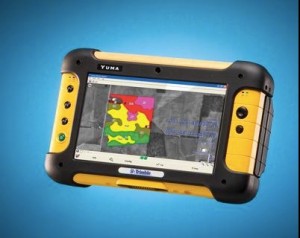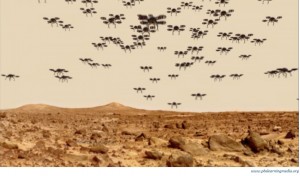Cows, Apps, Sheep, and Drones: High Tech Comes to Agriculture
A lot of people are counting on new technology to magically fix the problem of climate change and global warming. Plans range from technology to capture and store carbon emissions to grand schemes to seed clouds in the atmosphere to reflect sunrays away from the earth. There are many serious reservations about these mega-tech-fixes to climate. Will they work? Will they create unintended consequences that will destabilise climate systems? Who gets to decide how, when, and where to deploy such schemes? Probably the rich and powerful.
In the meantime, there are a rapidly developing range of high-tech devices and applications (apps) that are transforming our day-to-day lives, including in ways we interact with our environment. There are smart water meters, smart electric appliances, and smart electricity transmission grids that give us real-time data to so we can manage energy usage and save costs. There are solar and wind systems that can provide power to remote and poor communities
Perhaps the most versatile instrument in the new technology world (which is actually becoming the Old Tech World already) is the smart phone and the explosion of new apps. Now one can collect data, photograph and, with GPS, pinpoint the location and condition of natural resources. Such data can be used to conduct surveys of birdlife and water conditions. Rainforest Connection plans to turn old, unwanted Android phones into sophisticated listening devices that can help prevent illegal logging and poaching.
The new hot item is the drone, some of them costing €500-1,000. They can be used to monitor and help enforce against illegal exploitation of bogs, cutting down of rainforests, and illegal exploitation of other protected natural resources. They can also monitor or take pictures or film of a colony of sensitive animals without disturbing them.
Even the agriculture sector is getting in on the Internet Technology (IT) act, developing a world of Ag Tech. There are self-driving tractors, self-milking cows, mobile phones that can tell a farmer when cows are calving, software that measures how fast grass is growing.
Other developments include: air and soil sensors that provide real-time data on conditions on the farm, in the field; crop sensors that tell application equipment how much fertilizer to apply; agricultural robots (Agbots) that can harvest, pick fruit, plough, weed, maintain soils, plant and irrigate; 4G internet connection for remote locations; telematics that enable tablet computers to provide location and fuel level of equipment and how much crop has been harvested; radio frequency identification (RFID) that can tag animals and use small chips that will allow consumers to track individual products from cradle to grave and show what inputs were used and whether they are environmentally protective.
Drones are now being used to locate, count and even herd sheep, especially in large or remote areas. They could be used on commonage in Ireland.
The development of the Ag Tech world has grown through two phases. First there was electronic equipment attached to a source of data (tractors, milking machines, even cows and sheep) where the data had to be collected manually at the source. The second phase has been the use of the IT cloud which makes it possible to collect and store all the data in remote locations and allows parties like seed and fertilizer companies, as well as academic institutions, to have access to the collective data for research, planning, and product-development purposes.
Ag Tech is particularly suited to Ireland because of the many multi-national IT companies already established in Ireland, with a large well-trained work force.
While Ag Tech offers exciting possibilities for a more efficient and productive agriculture sector in Ireland, let us not forget that more cows and sheep bring more methane. Ireland already is unlikely to meet its GHG emissions under EU obligations, in large part because of the about 30% contribution from farming. So any embrace of Ag Tech requires an equal embrace of methane-reduction strategies. And some of the high tech devices, such as drones, should be deployed to oversee and enforce the environmental impacts from any growth in the farming sector.
Sources
David Roberts, “ ‘More research’ into geoengineering is not such a hot idea,” republished in Commentary section of irish environment magazine (1 March 2015). www.irishenvironment.com/commentary/david-roberts-research-geoengineering-hot-idea/
“How Your Old Cellphone Could Help Stop Illegal Logging And Poaching,” The Huffington Post Green (7 July 2014). www.huffingtonpost.com/2014/07/07/illegal-logging_n_5565090.html?utm_hp_ref=green
‘Irish inventors driving the high-tech farm of the future,’ Irish Independent (24 May 2015). www.independent.ie/business/technology/irish-inventors-driving-the-hightech-farm-of-the-future-31248410.html
Jack Nicas, ‘They’re Using Drones to Herd Sheep,” The Wall Street Journal (7 April 2015). www.wsj.com/articles/theyre-using-drones-to-herd-sheep-1428441684
Micahel Zappa, “ 15 Emerging Agricultural Technologies That Will Change The World,” Business Insider (5 May 2014). www.businessinsider.com/15-emerging-agriculture-technologies-2014-4
“20 technologies changing agriculture,” Farm Industry News (9 March 2011). farmindustrynews.com/precision-farming/20-technologies-changing-agriculture#slide-0-field_images-45641




No comments yet, add your own below